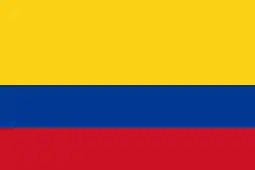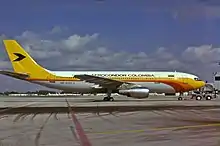Aerocondor Colombia
Aerocondor Colombia - Aerovías Cóndor de Colombia S.A. was a Colombian airline headquartered in Barranquilla, Colombia.
| |||||||
| Founded | February 3, 1955 | ||||||
|---|---|---|---|---|---|---|---|
| Ceased operations | June 16, 1980 | ||||||
| Hubs | Ernesto Cortissoz International Airport | ||||||
| Secondary hubs | El Dorado International Airport | ||||||
| Fleet size | 34 | ||||||
| Destinations | 29 | ||||||
| Headquarters | Barranquilla, Colombia | ||||||
History
Early Operations

Aerocondor Colombia was founded by six former LANSA[1] and Avianca pilots; Gustavo Lopez, Luis Donado, Eduardo Gonzalez, Juan B. Millon, Captain Julio Martin Florez, and Enrique Hanaberg, in association with two businessmen who together perceived an opportunity to establish a new airline to fly cargo from Colombia's northern industrial city of Barranquilla throughout the republic. Scheduled cargo services commenced on 7 October 1955[2] using Curtiss C-46 aircraft which were later complemented with Douglas DC-3s. Progressive expansion saw most of these aircraft later reconfigured for passenger services, and Douglas DC-4 and Douglas DC-6 aircraft were acquired during the early 1960s. International services between Barranquilla and Miami commenced during 1963. On May 1, 1969, the airline began re-equipping with L-188 Electras acquired from American Airlines. The Electras gradually replaced the airline's fleet of classic piston engine aircraft in the early 1970s.
Jet Operations

Aerocondor entered the jet age during December of 1972, purchasing an ex-American Airlines Boeing 720B. A Canadair CC-106 Yukon was also acquired for freight services during 1972 and a second ex-American Airlines Boeing 720B was added to the fleet during 1974. Introduction of jetliners modernized the airline's image and enabled it to begin operating jet services to Aruba, Curaçao, Guatemala City, Santo Domingo, Panama, and Port-au-Prince whilst also increasing the frequency of Miami services from Medellin, Bogotá, and San Andres. During 1975, financial control of Aerocondor passed from the company's foundation management to Jorge Barco Vargas, formerly an Aerocivil chairman and the brother of a former president of the republic. A new orange and yellow colour scheme was applied to some aircraft, including the Boeing 720s, from 1975.
By this time, Aerocondor had become a respected airline and was considered Colombia's second international airline. It also began to compete internationally with the country's national airline Avianca, to the concerns of both air traffic management and political representatives who wanted to protect Avianca's interests.
By this stage Aerocondor had grown to become Colombia's second international airline, and it was competing against the country's national flag carrier Avianca Colombia. In 1977 the airline entered the wide-body era when it acquired a factory fresh Airbus A300, named "Ciudad de Barranquilla" in honor of the company's port of origin. This was the first A300 operated within the Latin American region, entering service on highly competitive routes to Miami. Plans for the introduction of a second A300 failed to materialize due to fiscal underachievement under the airline's new management. The financially strapped carrier soon entered a period of major crisis, due to poor control and internal corruption rather than market forces.
Decline
The company entered into a financial crisis due to the delay of four monthly payments for the A300, which forced the company to return the aircraft to Airbus. Aerocondor was again sold during 1979 to the Cotes and Calderon brothers, the new president of the airline managed to overcome the crisis and recover the wide-body aircraft. However, the financial state declined and the company was again in crisis. On April 24, 1980, liquidation was ordered and the financial crisis ended Aerocóndor on June 16 of the same year. Hope remained that services would be reinstated, but negotiations between the pilots, liquidators and the Colombian government were unsuccessful. Over the years, several of the pensioners of the extinct airline have protested countless times demanding payment, overdue since the liquidation of the company. The airline's fleet of B707s and B720s were eventually stricken from the Colombian civil air register.
Destinations
National
 Colombia
Colombia
- Barranquilla (Ernesto Cortissoz International Airport)
- Barrancabermeja (Yariguíes Airport)
- Bogota (El Dorado International Airport)
- Cali (Alfonso Bonilla Aragón International Airport)
- Cartagena (Rafael Núñez International Airport)
- Cimitarra (Cimitarra Airport)
- Cucuta (Camilo Daza International Airport)
- Ibague (Perales Airport)
- Maicao (Jorge Isaacs Airport)
- Mariquita (Mariquita Airport)
- Medellin (Enrique Olaya Herrera Airport)
- Neiva (Benito Salas Airport)
- Pereira (Matecaña International Airport)
- Riohacha (Almirante Padilla Airport)
- San Andrés (Gustavo Rojas Pinilla International Airport)
- Santa Marta (Simon Bolivar International Airport)
- Tibú (Tibú Airport)
- Tolú (Golfo de Morrosquillo Airport)
- Turbo (Gonzalo Mejía Airport)
- Valledupar (Alfonso López Pumarejo Airport)
- Velázquez (Velasquez Airport)
International
Fleet

Aerocondor Colombia used throughout the years the following aircraft:[3]
- 1 Airbus A300B4
- 3 Boeing 707-120B (2 passenger and 1 cargo)
- 2 Boeing 720B
- 1 Canadair CC-106 Yukon
- 1 Cessna 180 Skywagon
- 2 Cessna T-50
- 7 Curtiss C-46 Commando
- 1 De Havilland Canada DHC-2 Beaver
- 2 Douglas DC-3
- 3 Douglas DC-4
- 3 Douglas DC-6B
- 1 Douglas DC-8-33F (leased)
- 7 Lockheed L-188A Electra
- 1 Lockheed L-1649A Starliner
Accidents and Incidents
- On December 18, 1966, a Lockheed L-1649A Starliner (registered N7301C), hit 10 to 20 meters from the runway on its flight from Miami to Bogota. At the time of the accident, there were clouds of fog over parts of the airport. The captain of the aircraft leased from the USA did not have a valid certificate of fitness to fly. Of the 59 people on board, 17 died.
- On February 22, 1975, a Canadair CL-44 (registered HK-1972) hit a tree 10 kilometers from the departure of El Dorado International Airport and fell 1,200 meters further into a mountain. All five crew members of the cargo plane were killed.[4]
- On July 10, 1975, a Lockheed L-188A Electra freighter (registered HK-1976) suddenly turned right shortly after taking off from El Dorado International Airport, sank back and crashed into an Aerocosta Douglas DC-6 (HK-756). Both planes caught fire and were destroyed. Two of the four crew members on board the Electra were killed.[5][6]
References
- Lansa
- R.E.G. Davies: Airlines of Latin America since 1919. Putnam Aeronautical Books, London 1997, ISBN 0-85177-889-5, p. 250.
- Ulrich Klee, Frank Bucher et al.: jp airline-fleets international 80. Zürich-Airport 1980, S. 89.
- "CL-44 HK-1972". Aviation Safety Network. 19750222-0. Retrieved January 13, 2019.
- "L-188AF HK-1976". Aviation Safety Network. 19750710-0. Retrieved January 13, 2019.
- "DC-6 HK-756". Aviation Safety Network. 19750710-1. Retrieved January 13, 2019.